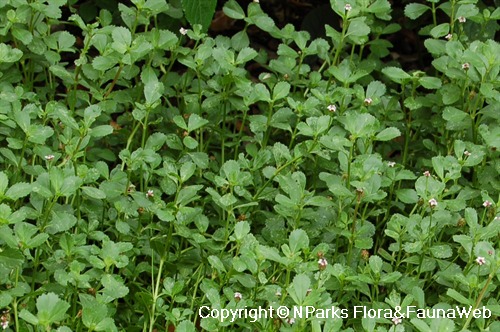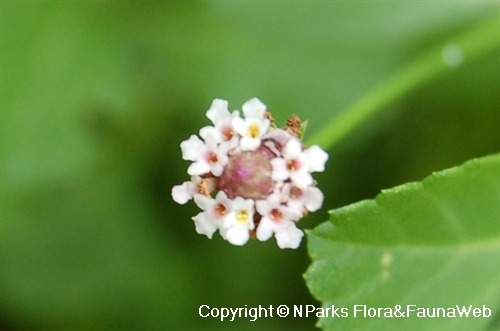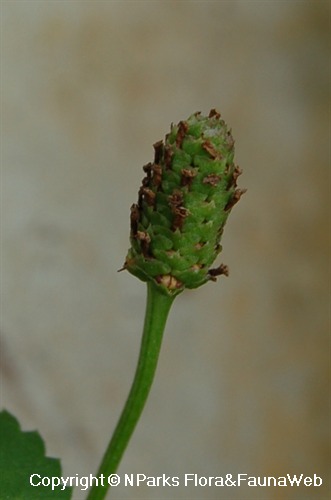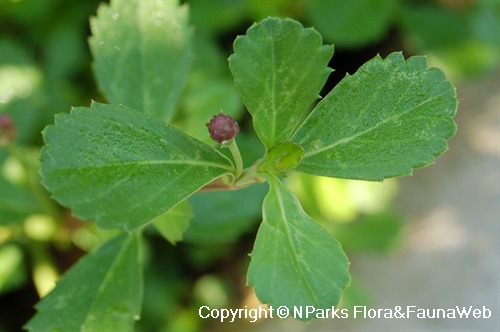
Back
Phyla nodiflora (L.) Greene
| Family Name: | Verbenaceae |
| Synonyms: | Phyla nodiflora var. repens, Lippia nodiflora var. reptans, Phyla nodiflora var. incisa, Lippia nodiflora, Phyla nodiflora var. longifolia, Phyla incisa, Lippia reptans, Phyla nodiflora var. nodiflora, Phyla nodiflora var. rosea |
| Common Name: | Texas Frogfruit, Sawtooth Frog-fruit, Lippia, Common Lippia, Matchweed, Creeping Lip Plant, Spatulate-leaved Frog-fruit, Weighty Frog-fruit, Wedge-leaf, Turkey-tangle, Turkey-tangle Fogfruit, Frogfruit, Capeweed, Matgrass, 过江藤, 鸭舌, 鸭舌癀, 鸭嘴黄 |
Name
Classifications and Characteristics
| Plant Division | Angiosperms (Flowering Seed Plants) (Dicotyledon) |
|---|---|
| Plant Growth Form | Herbaceous Plant, Creeper |
| Lifespan (in Singapore) | Perennial |
| Mode of Nutrition | Autotrophic |
| Plant Shape | Shrubby |
| Maximum Height | 0.1 m to 0.3 m |
Biogeography
| Native Distribution | USA |
|---|---|
| Native Habitat | Terrestrial (Riverine) |
| Preferred Climate Zone | Temperate |
| Local Conservation Status | Non-native (Spontaneous (Naturalised)) |
Description and Ethnobotany
| Growth Form | A perennial herb with spreading growth form, growing to about 15 cm tall. |
|---|---|
| Foliage | Leaves green, ovate or oblanceolate with serrate leaf margin from the middle to the tip of the leaf. Leaves have opposite arrangement. |
| Stems | The stem can be up to 0.9 m long. It becomes woody at the base as it matures. The stem is mostly yellow-green, but reddish brown near the tip and leaf nodes. |
| Flowers | A ring of small, white to pink, bi-labiate flowers (having 2 lips, 3 mm wide) surround a purple ovoid flowering head (1 - 3 cm long) near the top. The inflorescence occurs on a green to red-brown floral stalk. |
| Fruit | Produces capsules that break up into nutlets which are small, indehiscent, dry fruits. |
| Habitat | Occurs in wetlands, wet prairies and near rivers at altitudes of 0 - 400 m. Also becomes established in disturbed areas with moist soil (ponds, paddy fields, ditches, brackish water). |
| Cultivation | Although this plant prefers moist soil, a mature plant can withstand short periods of drought. Able to grow in poorly drained or nutrient poor soils, but not saline soils. However, it can tolerate salt spray. |
| Etymology | The genus name "Phyla" is Greek for clan or tribe. It refers to how species in this genus often have many flowers that occur in tight clusters. The species epithet "nodiflora" is Latin for a term that means that flowers emerge from nodes. The common name "Matchweed" comes from the fact that the floral stalk and inflorescence together resemble a match. |
| Ethnobotanical Uses | Food (Herb or Spice) Medicinal: Traditionally, the plant has been used to treat constipation and knee pain. Leaves and immature stalks are used to make infusions that are administered to children with indigestion or women that have recently delivered a baby. A paste produced from the plant is also applied to boils and ulcers. Freshly pressed juice from the leaves is used on gums to stop bleeding. Others: Leaves can be fed to cattle. |
Landscaping Features
| Landscaping | Excellent groundcover that can withstand both drought and flooding. However, care must be taken to restrain its growth, because it can overtake lawns or gardens due to its fast growth rate. Also good for hanging baskets. May be planted next to water gardens. |
|---|---|
| Desirable Plant Features | Ornamental Flowers |
| Landscape Uses | General, Turf / Lawn / Sports Field, Groundcover, Container Planting, Suitable for Hanging Baskets |
| Plant & Rootzone Preference or Tolerance Remarks | Can tolerate salt spray, but not saline soil. |
Fauna, Pollination and Dispersal
| Fauna Pollination Dispersal Associated Fauna | Butterfly-Attracting |
|---|---|
| Pollination Method(s) | Biotic (Fauna) (Insects (Butterfly, Moth)) |
Plant Care and Propagation
| Light Preference | Semi-Shade, Full Sun |
|---|---|
| Water Preference | Lots of Water, Moderate Water |
| Plant Growth Rate | Fast |
| Rootzone Tolerance | Easy to Grow, Waterlogged Soils (Drains Site) |
| Maintenance Requirements | Moderate |
| Propagation Method | Stem Cutting |
Foliar
| Foliage Retention | Evergreen |
|---|---|
| Mature Foliage Colour(s) | Green |
| Mature Foliage Texture(s) | Smooth |
| Foliar Type | Simple / Unifoliate |
| Foliar Arrangement Along Stem | Opposite |
| Foliar Shape(s) | Non-Palm Foliage (Ovate) |
| Foliar Venation | Pinnate / Net |
| Foliar Margin | Serrate / Toothed |
| Foliar Apex - Tip | Rounded |
| Foliar Base | Cuneate |
| Typical Foliar Area | Microphyll ( 2.25cm2 - 20.25 cm2 ) |
Non - Foliar and Storage
| Stem Type & Modification | Herbaceous |
|---|---|
| Root Type | Underground (Tap Root) |
Floral (Angiosperm)
| Flower & Plant Sexuality | Unisexual Flowers , Monoecious |
| Flower Colour(s) | White |
|---|
| Flower Grouping | Cluster / Inflorescence |
| Flower Location | Terminal |
| Flower Symmetry | Bilateral |
| Individual Flower Shape | Labiate / Lipped |
| Flower Size - Remarks | 3 mm wide |
| Inflorescence Type | Spike |
| Flowering Period | Free-Flowering |
Fruit, Seed and Spore
| Fruit Classification | Simple Fruit |
|---|---|
| Fruit Type | Dehiscent Dry Fruit , Capsule |
Image Repository
Others
| Master ID | 29407 |
|---|---|
| Species ID | 3716 |
| Flora Disclaimer | The information in this website has been compiled from reliable sources, such as reference works on medicinal plants. It is not a substitute for medical advice or treatment and NParks does not purport to provide any medical advice. Readers should always consult his/her physician before using or consuming a plant for medicinal purposes. |







